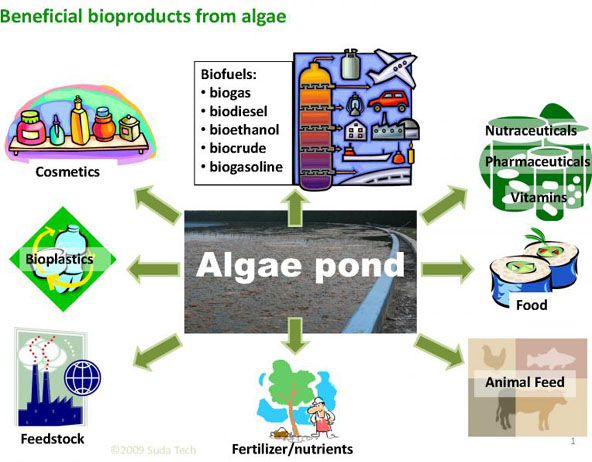
FOOD
Several species of algae are raised for food.
Purple laver (Porphyra) is perhaps the most widely domesticated marine algae. In Aisa it is used in Nori (Japan) and Gim (Korea). In Wales, it is used in laver-bread a traditional food, and in Ireland it is collected and made a traditional food, and in Ireland it is collected and make into felly by stewing or boiling. Preparation also can involve frying or heating the fronds with a little water and beating with a fork to produce a pinkish jelly. Harvesting also occurs along the west coast of North America, and in Hawaii and New Zealand.
Dulse (Palmaria palmata) is a red species sold in Ireland and Atlantic Canada. It is eaten raw, fresh, dried, or cooked like spinach.
Spirulina (Arthrospira platensis) is a blue-green microalgae with a long history as a food source in East Africa and pre-colonial Mexico. Spirulina is high in protein and other nutrients, finding use as a food supplement and for malnutrition. Spirulina thrives in open systems and commercial growers have found it well-suited to cultivation. One of the largest production sites is Lake Texcoco in central Mexico. The plants produce a variety of nutrients and high amounts of protein. Spirulina is often used commercially as a nutritional supplement.
Chlorella, another popular microalgae, has similar nutrition to spirulina. Chlorella is a very popular in Japan. It is also used as a nutritional supplement with possible effects on metabolic rate. Some allege that Chlorella can reduce mercury levels in humans (supposed by chelation of the mercury to the cell wall of the organism).
Irish moss (Chondrus crispus), often confused with Mastocarpus stellatus, is the source of carrageenan, which is used as a stiffening agent in instant puddings, sauces, and dairy products such as ice cream. Irish moss is also used by beer brewers as a fining agent.
Sea lettuce (Ulva lactuca), is used in Scotland where it is added to soups and salads. Dabberlocks or badderlocks (Alaria esculenta) is eaten fresh or cooked in Greenland, Iceland, Scotland and Ireland.
Aphanizomenon flos-aquae is a cyanobacteria similar to spirulina, which is used as a nutritional supplement.
Extracts and oils from algae are also used as additives in various food products. The plants also produce Omega-3 and Omega-6 fatty acids, which are commonly found in fish oils, and which have been shown to have positive health benefits.
Sargassum species are the important group of seaweed. These algae have many phlorotannins.
FERTILIZER AND AGAR
For centuries seaweed has been used as fertilizer. It is also an excellent source of potassium for manufacture of potash and potassium nitrate.
Both microalgae and macroalgae are used to make agar.
POLLUTION CONTROL
With concern over global warming, new methods for the thorough and efficient capture of CO2 are being sought out. The carbon dioxide that a carbon-fuel burning plant produces can feed into open or closed algae systems, fixing the CO2 and accelerating algae growth. Untreated sewage can supply additional nutrients, thus turning two pollutants into valuable commodities.
Algae cultivation is under study for uranium/plutonium sequestration and purifying fertilizer runoff.
ENERGY PRODUCTION
Business, academia and governments are exploring the possibility of using algae to make gasoline, diesel and other fuels.
OTHER USES
Chlorella, particularly a transgenic strain which carries an extra mercury reductase gene, has been studied as an agent for environmental remediation due to its ability to reduce Hg2+ to the less toxic elemental mercury.
Cultivated algae serve many other purposes, including bioplastic production, dyes and colorant production, chemical feedstock production, and pharmaceutical ingredients.
Principles of aquaculture and fish farming in including other species such as algae, oyster, seaweed and more- Edited by Laura Vermon from high quality Wikipedia articles (Page 92-93)
Photo: http://rudydean.blogspot.com/2012/10/the-future-of-algae.html